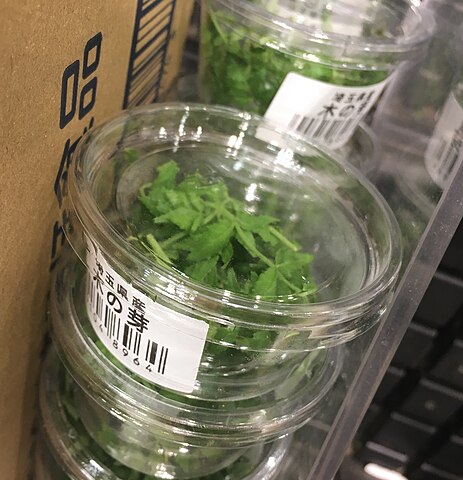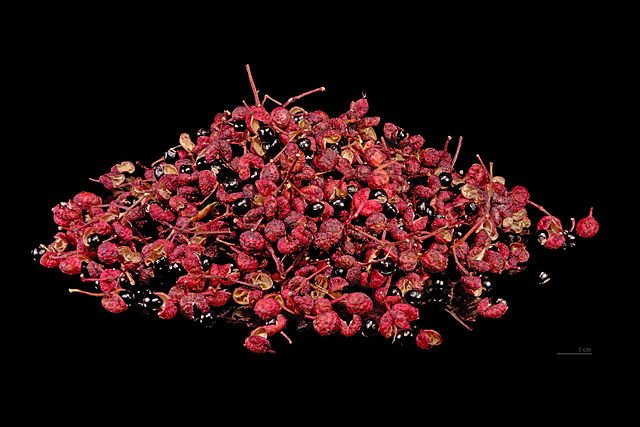Sansho (Zanthoxylum piperitum) is a species of deciduous tree native to Japan, Korea, and China. The tree grows to an average height of 10-15 meters. The leaves are simple and ovate-shaped, with a serrated margin.
Sansho can be used as a spice in cooking; the fruits and leaves have a sharp, citrusy flavor. Sansho is also used in traditional medicine.
The Sansho pepper is a type of Japanese chili pepper that is typically used to flavor fish and other seafood dishes. It has a sharp, citrusy flavor that can add a real kick to your meals.
Sansho produces small, greenish-yellow flowers that bloom in early summer. The flowers are followed by small, red fruits that ripen in late summer.
Sansho can be grown from seed or cuttings. For best results, seedlings should be started in early spring. Sansho prefers full sun and well-drained soil. Once established, the tree is drought tolerant.
Sansho is susceptible to insect pests and diseases, but generally speaking, it is a hardy plant. Regular pruning is necessary to keep the tree in shape.

Soil composition and ph level
Sansho is a beautiful, ornamental plant that is native to Japan. Sansho grows best in rich, well-drained soil with a pH balance of 6.5 to 7.5. Sansho does not tolerate wet or heavy soils.
The ideal potting mix for Sansho would be two parts loam, one part sand, and one part organic matter. Sansho also requires full sun to partial shade and should be watered regularly.
For more information on growing Sansho, please consult a professional gardener or horticulturist.

Watering Sansho pepper tree
Sansho is a member of the citrus family, and its leaves and fruit contain high levels of citric acid. The Sansho plant grows best in moist, well-drained soil.
It prefers full sun but will tolerate partial shade. Sansho should be watered regularly during the growing season.
If the plant becomes too dry, the leaves will turn yellow and drop off. During the winter months, Sansho should be water only enough to keep the soil moist. Overwatering can cause root rot.
Flowering in Sansho pepper tree
The Sansho will flower in late spring or early summer. The flowers are tiny and yellow-green, growing in clusters. Sansho fruits will mature in late summer or early fall.
Fruiting of Sansho pepper tree
Sansho typically blooms in late spring or early summer, and the blossoms are followed by small, green fruits. The fruits ripen to a red or black color in late summer or early fall. When ripe, the fruits can be eaten fresh or used to make sansho pepper.

Propagation of Sansho pepper
Sansho can be propagated by seed, root cuttings, or stem cuttings.
Seed: Sansho seeds can be sown indoors 6-8 weeks before the last frost date. Sow the seeds on the surface of a well-draining potting mix and keep the soil moist but not wet.
Seedlings will emerge in 21-30 days. When they are big enough to handle, transplant them into individual pots.
Root Cuttings: Sansho can also be propagated by root cuttings. Take root cuttings from young plants in late winter or early spring. Cut 4-6 inch sections of roots and plant them in a well-draining potting mix.
Keep the soil moist but not wet and roots will begin to grow within 2-3 weeks. When new growth appears, transplant the rooted cuttings into individual pots.
Stem Cuttings: Sansho can also be propagated by stem cuttings. Sansho stem cuttings should be taken from new growth that is at least 6 inches long. The cutting should have at least 2 leaves attached. Sansho stem cuttings can be rooted in water or soil.
To root Sansho stem cuttings in water, fill a jar or glass with water and place the cutting in the water. Pour out the water every few days and replace it with fresh water.
Keep the jar or glass in a bright, warm location out of direct sunlight. To root Sansho stem cuttings in soil, fill a pot with a well-draining potting mix. Water the potting mix well and allow it to drain before planting the cutting.
Insert the cutting into the potting mix at a 45-degree angle. Water the potting mix well and keep it moist but not wet. Place the pot in a bright, warm location out of direct sunlight. Sansho stem cuttings should root within 4-6 weeks.
Once rooted, transplant to individual pots filled with well-draining potting soil.
Pests and diseases that affect Sansho
The Sansho plant is susceptible to a number of pests and diseases, so it is important to take measures to protect the plant from these threats. Sansho is particularly vulnerable to aphids, scale insects, and whiteflies.
These pests can cause damage to the leaves, stems, and flowers of the Sansho plant. To control these pests, it is important to regularly monitor the plant and take steps to remove the pests when they are found.
Sansho is also susceptible to fungal diseases such as powdery mildew and leaf spot. These diseases can be controlled by providing adequate ventilation for the plant and avoiding overhead watering.
Irritation to pets from Sansho
Although Sansho is safe for humans to consume, it can be irritating to pets. Sansho contains compounds that can cause vomiting and diarrhea in dogs and cats. If your pet ingests Sansho, it is important to seek veterinary care immediately.
Symptoms of Sansho poisoning in pets include vomiting, diarrhea, drooling, and lethargy. Sansho plants should be kept out of reach of pets at all times.
Benefits of Sansho
Sansho pepper is a plant that is native to Asia. It is related to the Chinese Sichuan pepper and the Japanese shiso plant. The Sansho pepper plant has many benefits. Some of these benefits include:
- Sansho peppers can help to improve digestion.
- They can also help to relieve gas and bloating.
- Sansho peppers can assist in weight loss by helping to speed up metabolism.
- Additionally, they can help to improve circulation and boost energy levels.
The Sansho pepper plant is a versatile one that can be used in many different dishes. It has a unique flavor that is both pungent and slightly sweet.
If you are looking for a way to add some flavor to your food, sansho peppers may be a good option for you.
Best planting time for Sansho
The best planting time for Sansho is in the spring, after the last frost has passed. The plant prefers full sun and well-drained soil.
When planting, be sure to space the plants 18-24 inches apart to allow for proper growth. Sansho is a perennial plant, meaning it will come back year after year with proper care. To promote healthy growth, fertilize the plants in early spring and mid-summer.
Water regularly during the growing season, especially during periods of drought.

Caring for Sansho
The best time to plant Sansho pepper is in early spring, as soon as the ground can be worked. The plants should be started indoors, in a sunny location, 6-8 weeks before the last frost date.
Sansho peppers can also be direct-seeded outdoors, but the seedlings will need to be protected from frost.
When transplanting seedlings, bury them up to the first set of leaves. This will encourage the development of a strong root system.
Companion plants for Sansho
When choosing companion plants for Sansho, it is important to consider the flavor profile of the pepper. Sansho is typically very spicy, so it is important to choose plants that will not be overpowered by the heat.
Companion plants for Sansho should also have similar growing requirements, such as full sun and well-drained soil. Some good Companion plants for Sansho include:
- Eggplant
- Tomatoes
- Cucumbers
- Radishes
- Carrots
- Beets
- onions
- garlic
- chives
- cilantro
- Alliums These plants all have flavors that can stand up to the heat of the Sansho pepper, and they also have similar growing requirements.
Growing Sansho pepper in containers and pots
Growing Sansho pepper in containers and pots is a great way to add spice to your cooking. If you are interested in growing Sansho peppers, there are a few things you need to know.
First, Sansho peppers need full sun in order to thrive. They also need well-draining soil that is high in organic matter.
As with most chili peppers, it is important to keep the plants watered regularly during the growing season. However, be sure not to overwater, as this can lead to root rot.
Finally, when harvesting the peppers, you will want to wear gloves to avoid getting the spicy oils on your skin.

How long does it take to grow Sansho?
How long does it take to grow Sansho? It takes a long time to grow Sansho. Sansho is a long-term crop.
It takes at least ten years to mature. The average Sansho tree is about 15 years old. However, some trees can live for hundreds of years.
Planting and spacing details for Sansho
Planting and spacing for Sansho:
- Plant sansho in well-drained soil in full sun to partial shade.
- Space plants 3 to 5 feet apart.
- Plant sansho in early spring, after the last frost date.
- Mulch plants heavily to keep roots cool and moist.
- Water plants regularly during the growing season.
- Apply a balanced fertilizer once a month during the growing season.
- Sansho can be susceptible to root rot, so plant in an area with good drainage.
- Propagate sansho by seed or stem cuttings.

Varieties of Sansho pepper
There are many varieties of Sansho pepper, each with its own unique flavor profile. The most common variety is the Japanese Sansho pepper, which has a sharp, citrusy flavor.
Other popular varieties include the Chinese Sansho pepper, which has a milder, sweeter flavor, and the Korean Sansho pepper, which has a fiery, spicy flavor.
While Sansho peppers are typically used to add heat and flavor to dishes, they can also be used as a standalone seasoning.
Are Szechuan and Sansho pepper the same?
Szechuan and Sansho are both types of peppers, but they are not the same.
Szechuan is a more common type of pepper that is used in Chinese cuisine. It has a slightly spicy taste with numbing properties.
Sansho, on the other hand, is a Japanese pepper that is used in Sichuan cuisine. It is less spicy than Szechuan pepper and has a citrusy flavor.
In a nutshell, Szechuan and Sansho peppers are two different types of peppers that are used in different cuisines.




